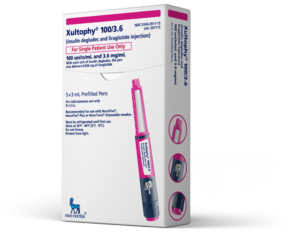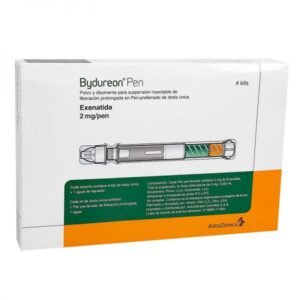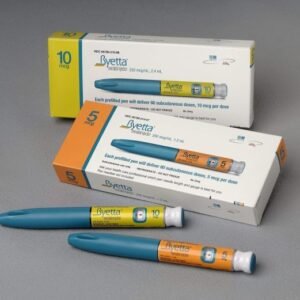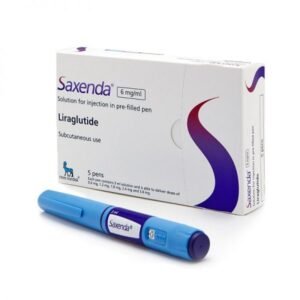Buy XULTOPHY 100/3.6 Online
What is Xultophy?
Xultophy 100/3.6 is a brand-name prescription basal insulin (Insulin degludec) and a GLP-1 receptor agonist (liraglutide).
It comes in a liquid solution prefilled pen which holds 3 ml of solution that contains:
- 100 units of Insulin degludec. This is a long-acting insulin that is similar to the insulin naturally produced by the pancreas in our body.
- 3.6 mg of liraglutide, also known as a glucagon-like peptide 1 (GLP-1) receptor agonist which works to lower blood glucose levels.
Xultrophy is approved to lower blood sugar levels in adults with type 2 diabetes who aren’t able to manage their blood sugar levels using other diabetes drugs. Diet and exercise should are typically recommended in combination as part of insulin treatment.
Testing hemoglobin A1c (HbA1c) is often used to measure a person’s response to their insulin treatment. This measurement provides information on the average blood glucose levels over a period of 3 months.
According to the American Diabetes Association, the recommended HbA1c goal should be less than 7% for most adults.
- 1.67% to 1.94% with Xultophy 100/3.6, compared to 1.05% to 1.16% with long-acting insulins
- 1.31% with Xultophy 100/3.6, compared to 0.36% with liraglutide
- 1.81% with Xultophy 100/3.6, compared to 1.35% with insulin degludec and 1.21% with liraglutide
- 1.42% with Xultophy 100/3.6, compared to 0.62% with placebo
- 1.97% with Xultophy 100/3.6, compared to 1.59% with insulin glargine
USAGE & STORAGE
How to Use Xultophy 100/3.6?
Xultophy 100/3.6 is administered by subcutaneous (under the skin) injection once per day. It is injected in areas such as the upper arm, thigh, or abdomen.
If you are not sure how to administer the prefilled injection pen, consult your doctor or pharmacist for instructions.
It must not be injected into a vein or try use with an infusion pump.
Your doctor may ask you to monitor your blood sugar levels and adjust your insulin dose until your fasting glucose levels are appropriate for you. Factors such as your blood glucose values and lifestyle will determine the recommended dosage.
Do not use this medication if it appears cloudy or discolored or looks clumpy. It should not be mixed with other insulins or solutions. Shaking this medication before use is unnecessary.
Xultophy Dosage
The recommended starting dose of Xultophy 100/3.6 depends on whether an individual has previously used basal (long-acting) insulin or a GLP-1 inhibitor.
The maximum recommended dose of Xultophy 100/3.6 is 50 units of insulin degludec/1.8 mg of liraglutide injected once daily.
Several factors can affect the dosage such as an individual’s body weight, existing medical conditions, and other medications currently being taken. Follow your doctor’s recommendation for Xultophy dosage exactly as prescribed regardless of information received from external sources such as the internet. Do not adjust your treatment without consulting your doctor first.
If you miss a dose, skip the missed dose and continue with your usual dosing routine. Speak to your doctor if you miss 3 consecutive doses and how to resume your dosing schedule. Never take a double dose to make up for a missed dose. Consult your doctor or pharmacist if you are not sure what to do if you miss a dose.

Storage
Prior to using your Xultophy 100/3.6 prefilled pen, store the medication in the refrigerator in its original carton.
Do not freeze the medication and discard it if it has been frozen.
Protect this medication from moisture and direct light.
Keep away from children and pets.
After first use, Xultophy 100/3.6 prefilled pens can be stored at room temperature for up to 21 days.
Discard medication if there is any remaining after 21 days and start a new one.
Do not dispose of medication in household trash or down wastewater (i.e. toilet or skink).
Speak to your pharmacist about how to properly dispose of medication if it has expired or is no longer needed.
Xultophy Side Effects
As with any medication, side effects can occur. The information below covers some of the common and serious side effects that patients may experience while taking Xultophy 100/3.6. The information below does not cover all possible side effects Consult with your doctor or pharmacist about the risks and potential side effects. They can provide tips on how to avoid and better manage side effects that can be bothersome.
Common Side Effects of Xultophy
Some common Side Effects with Xultophy 100/3.6 can include:
- hypoglycemia (low blood sugar)
- infections such as a cold
- headache
- diarrhea
- nausea
Most side effects associated with Xultophy 100/3.6 go away after a few days or a couple of weeks. Consult with your doctor or pharmacist if side effects do not go away with time.
Serious Side Effects
These side effects are not common but can occur. Immediately contact your doctor if you experience any serious side effects or call 911 or visit a hospital if you feel symptoms are life-threatening.
Serious Side Effects with Xultophy 100/3.6 can include:
- Pancreatitis (this is an inflammation of the pancreas). Symptoms may include:
feeling serious pain in your mid-section - vomiting
Kidney damage or failure. Symptoms can include:
- nausea
- vomiting
- feeling weak or tired
- swelling in legs, feet, or ankles
- confusion
- difficulty breathing
Gallbladder damage Symptoms may include:
- fever
- serious pain in the mid-section (upper stomach)
- nausea
- vomiting
- whites of eyes and skin become yellow
Hypokalemia (low potassium level) Symptoms may include:
- sudden muscle contractions (muscle spasms or cramps)
- muscle stiffness or aches
- extreme tiredness or weakness
- irregular or rapid heartbeat
- numbness or tingling in the arms, legs, hands or feet
Other serious side effects include:
- Severe hypoglycemia
- Severe allergic reaction
- Possible risk of thyroid cancer. Xultophy 100/3.6 has a boxed warning issued by the Food & Drug Administration that alerts doctors and users of the potential side effects of using this medication. A boxed warning is the most serious issue by the FDA.
Side Effect Details of XULTOPHY
Below is additional information on the side effects taking Xultophy 100/3.6 may or may not experience.
Headaches
Some patients may experience headaches while taking Xultophy 100/3.6. It was found that 9.1% of people taking Xultophy 100/3.6 got headaches during a clinical study. Headaches can also be a sign of low blood sugar levels (hypoglycemia).
Speak to your doctor if you are experiencing headaches while taking Xultophy 100/3.6. Let them know how often they occur and the severity. Your doctor may provide medication to help improve your headaches.
Allergic Reaction
There aren’t any clinical studies showing allergic reactions to Xultophy 100/3.6 however some patients have reported allergic reactions. The frequency of allergic reactions is not known.
Symptoms of allergic reactions may include
- itchiness
- skin rash
- flushing (skin redness & warmth)
Symptoms of more severe allergic reactions may include:
- difficulty breathing
- swelling under the skin (typically eyelids, hands, feet, and lips)
- swelling of your mouth, tongue, or throat
If you experience any severe allergic reactions after taking Xultophy 100/3.6, contact your doctor immediately. If you feel the symptoms are life-threatening call 911 or seek a medical emergency.
Diarrhea
One of the more common side effects of taking Xultophy 100/3.6 is diarrhea. 7.5% of patients taking Xultophy 100/3.6 in a clinical study experienced diarrhea.
Typically, mild diarrhea only lasts a few days and isn’t a major concern. However, more severe diarrhea can lead to dehydration (a loss of fluid in the body) if it persists for a long period of time.
Drink plenty of fluids if you experience diarrhea. Avoid sugary drinks such as soda or juice. These beverages can worsen your diabetes symptoms as they can raise blood sugar levels.
Typically those who experience diarrhea after starting Xultophy 100/3.6, have it for a few weeks before it goes away. If your diarrhea persists speak to your doctor as they can recommend ways to better manage it.
Weight Gain or Weight Loss Using Xultophy
Weight gain can occur with patients using insulin. In a clinical study, it was found that users gained 4.4 pounds after they switched from Victoza (liraglutide) only to Xultophy 100/3.6 (a combination of insulin and liraglutide).
During clinical trials, weight loss was not a common side effect for patients taking Xultophy 100/3.6. However, Xultophy 100/3.6 is normally used in combination with diet and exercise which can lead to weight loss.
If you have any concerns about weight gain or weight loss, speak to your doctor. They may refer to you to a dietician or nutritionist who may also help you better manage your diabetes.
Hypoglycemia
Patients using Xultophy 100/3.6 may experience hypoglycemia (low blood sugar). This is common among taking drugs that contain insulin such as Xultophy 100/3.6.
Between 14.4% – 37.2% of people taking Xultophy 100/3.6 experienced hypoglycemia during a clinical trial. During these studies, patients were considered to have hypoglycemia if they had blood sugar levels less than 54 mg/dL.
Symptoms of hypoglycemia can include:
- dizziness
- lightheadedness
- weakness
- shakiness
- difficulty speaking or seeing
- hunger
- headache
- sweating
- rapid heartbeat
- drowsiness
- feeling confused
Speak to your doctor if you are experiencing episodes of hypoglycemia. Your doctor may choose to recommend a lower dose of Xultophy 100/3.6, make adjustments to other drugs you may be taking and recommend carefully monitoring glycemia levels.
Upper Respiratory Infections
Patients using Xultophy 100/3.6 may have upper respiratory infections such as the common cold. These are common side effects experienced by users taking Xultophy 100/3.6. 5.7% of people taking Xultophy 100/3.6 experienced upper respiratory infections during a clinical study.
Since there isn’t a cure for the common cure, the following may help:
- get plenty of rest
- stay hydrated (drink plenty of water)
- eat a healthy diet
Consult your doctor or pharmacist if symptoms are worse and your cold persists longer than 7-10 days. They may provide recommendations if you require medical assistance.
Thyroid Cancer
Xultophy 100/3.6 has a boxed warning for thyroid tumors and a type of thyroid cancer called medullary thyroid carcinoma (MTC) issued by the Food & Drug Administration (FDA).
Liraglutide has been known to increase thyroid tumors and cancer in rats and mice during animal studies. While animal studies do not directly reflect what can happen in humans MTC has been reported in some humans. It was unknown whether liraglutide was responsible for cancer in these subjects.
In clinical studies involving people taking Victoza (a drug that contains liraglutide), it was found that 7 people developed papillary thyroid cancer. One other person who developed thyroid cancer was taking rosiglitazone (Avandia) and metformin.
Your doctor should discuss the possible risks of cancer and thyroid tumors while taking Xultophy 100/3.6. Inform your doctor if you have symptoms of thyroid cancer which may include:
- having a lump on your neck
- difficulty swallowing or breathing
- constantly having a raspy voice
You should not take Xultophy 100/3.6 if you or a family member currently has or has had MTC in the past or if you have multiple endocrine neoplasia syndrome type 2 (MEN 2), which is a condition that causes tumors in your endocrine glands.
Speak to your doctor if you have concerns about the risk of thyroid cancer while using Xultophy 100/3.6.
WARNINGS & PRECAUTIONS of XULTOPHY
Before you start taking Xultophy 100/3.6 you should let your doctor know if you have any notable allergies or medical conditions, drugs you are currently taking, if you are pregnant or breastfeeding or any other significant facts about your current health and medical history. These factors may affect how your doctor chooses to adjust your treatment.
Thyroid Cancer
Xultophy 100/3.6 should not be used by patients with a personal or family history of medullary thyroid cancer, multiple endocrine neoplasia types 2 (tumors in your glands), if you are experiencing episodes of low blood sugar or diabetic ketoacidosis, or if you have insulin-dependent diabetes.
Animal studies on liraglutide have shown to cause thyroid tumors or thyroid cancer however it is not conclusive whether this would occur in humans.
Contact your doctor at once if you suspect you have signs of thyroid tumors such as difficulty swallowing, shortness of breath, a hoarse voice, or a lump or swelling in your neck.
Blood Glucose Monitoring
For anyone taking Xultophy 100/3.6 or any insulin, it’s important to regularly monitor your glycemic levels or as instructed by your doctor. Testing glucose levels is especially important if you become ill, are stressed or if insulin schedules change. Inform your doctor if blood sugar levels are consistently showing low levels.
Diabetes Identification
It’s important to let family and friends know you have diabetes and that you are currently taking insulin. You should also carry an ID card, necklace, or bracelet that lets others know you are diabetic. This can inform others in the event you lose consciousness.
Heart Problems
Inform your doctor if you have any existing heart conditions such as if you have heart disease (angina, heart failure, recent heart attack) or abnormal heartbeat (i.e. rapid heart rate or heart block). Xultophy 100/3.6 can lead to fluid build-up that can result in heart failure or increased heart rate that can affect how electrical impulses travel to the heart. If you develop symptoms of heart problems such as rapid heartbeat, chest pain, difficulty breathing, or swelling of the ankles, contact your doctor. Consult your doctor on how your existing condition may impact effectiveness and dosing and whether monitoring is required.
Injection Site Rotation
Repeated injections at the same area may cause the fatty tissue under the skin to thicken or shrink. To avoid this from happening, rotate injection sites regularly. Inform your doctor if you begin to notice skin thickening or pitting at injection sites.
Intestinal Problems
The effectiveness and safety of using Xultophy 100/3.6 for people who have a slowed movement through the intestinal tract due to their diabetes or have inflammatory bowel diseases such as Crohn’s disease or ulcerative colitis have not been established. Consult your doctor if you have any digestive issues, whether special monitoring is required or how your condition may affect dosing, effectiveness, and treatment.
Kidney Function
The effectiveness and safety of using Xultophy 100/3.6 for patients with reduced kidney function have not been established. To prevent dehydration, ensure you are drinking enough water especially if you are in extreme heat; or experiencing vomiting or diarrhea. If you have kidney disease or reduced kidney function, speak to your doctor about how this medication may impact the effectiveness and dosing, whether special monitoring is required or how it will impact your condition.
Hypoglycemia (low blood sugar levels)
Patients using insulin may be at risk of experiencing hypoglycemia (low blood sugar).
Mild symptoms of hypoglycemia may include:
- cold sweat
- nervousness
- shakiness
- rapid heartbeat
- headache
- hunger
- confusion
- lightheadedness
- weakness
- tingling or numbness of tongue, lips, or fingers
If patients experience mild to moderate hypoglycemia, this can be treated by consuming a glucose tablet, sugar snack (jelly beans, raisins, sugar packet, etc.), or sugar drink (juice or non-diet soda).
Severe symptoms of hypoglycemia may include:
- disorientation
- loss of consciousness
- seizures
Do not take insulin if you experience symptoms of hypoglycemia. If patients lose consciousness and cannot consume sugar orally they may require a glucagon injection or intravenous (into the vein) treatment of glucose.
Pancreatitis (inflammation of the pancreas)
Liraglutide on its own has been associated with pancreatitis. Consult your doctor if you are experiencing symptoms of pancreatitis such as abdominal pain that may move to the back or vomiting. If you have had pancreatitis in the past, speak to your doctor about how it may affect your treatment and whether special monitoring is required.
Hypokalemia (low potassium levels)
Liraglutide can lead to decreased levels of potassium in the body which can lead to muscle cramping in the arms and legs, weakness, tiredness, nausea, vomiting, tingling, or numbness. Severely low potassium levels may lead to irregular heartbeat or fainting. Inform your doctor if you experience any of these symptoms.
Pregnancy
Xultophy 100/3.6 should not be used by patients who are pregnant unless under the direction of your doctor who has outweighed the risks and benefits. Contact your doctor immediately if you become pregnant while taking this medication.
Breastfeeding
It is unknown whether insulin degludec or liraglutide passes through breast milk. Consult your doctor whether it is safe for you to continue taking your medication while breastfeeding as it may affect your baby.
Children
It has not been established whether Xultophy 100/3.6 is safe for children.
Seniors
Seniors over the age of 65 are at greater risks of side effects. Your doctor may need to adjust your Xultophy dosage compared to other adults.














Reviews
There are no reviews yet.